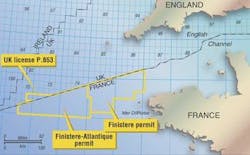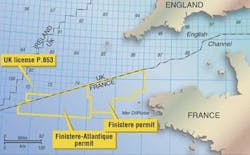Offshore Europe
Jeremy Beckman • London
Deepwater continues to disappoint
Norway's oil and gas reserves have been downgraded by 7% to 12.8 bcm of oil equivalent. The Norwegian Petroleum Directorate says its latest estimate reflects revised thinking about the Norwegian Sea's undiscovered gas resources. NPD has also lowered its expectations for improved gas recovery throughout the Norwegian shelf.
The newfound pessimism relates to dismal showings from deepwater wells drilled by the major operators off mid-Norway, the latest being ExxonMobil's Hvitveis exploratory well in 1,300 m of water in the Voering basin. Gas was found, but in minor quantities. Deepwater hopes are now pinned on Statoil's current well on the Ellida prospect, 60 km north of Ormen Lange, using the drillship West Navigator. This is an untested play in a region barely touched by the drill bit.
If Ellida also flops, there will be renewed pressure on the government to open the Lofoten/ Barents Sea areas in the far north to exploration drilling. Powerful fishing and environmental lobbyists have kept the oil industry out, but a recent study by the Ministry of Petroleum and Energy weakened their case. This report does not make recommendations, but it does state that year-round petroleum operations in this region would not have a major environmental impact, in terms of discharges.
NPD has also argued that these areas present no greater technical or operational challenges to the industry than anywhere else on the shelf. The study is out for public consultation, with comments due by Oct. 1. The government will then make recommendations that will be debated by Norway's parliament (Storting), leading to a possible decision by year-end.
Life extension for Tampen fields
Gullfaks, one of Statoil's flagship North Sea fields, has reached the 1.88 Bbbl output mark – 570 MMbbl above the original production forecast. Statoil puts the increased upside down primarily to use of advanced well engineering, 4D seismic, and reservoir mapping techniques.
Similar programs have also helped boost recovery at Heidrun and Norne in the Norwegian Sea by 24% and 42%, respectively, above expectations.
Over the longer term, Statoil's main current preoccupation is its Tampen 2020 field life extension project. The Tampen area of the North Sea covers eight production licenses and includes Gullfaks, Statfjord, Snorre, Visund, and numerous other smaller fields.
According to an article in Statoil's latest house magazine, the best options for extending production from the Gullfaks and Snorre reservoirs appear to be pressure maintenance and injection of both gas and water. At Statfjord, on the other hand, lowering pressure is seen as the optimum solution. A new plan is being prepared that will involve producing the field's gas, instead of injecting it, as at present.
Other ideas tabled for the Tampen area as a whole include a new platform for shared processing and exports, upgrades of existing installations, and leasing capacity from the Brent field platforms on the UK side of the North Sea median line.
One of Statoil's emerging production centers is Melkoya Island in the Barents Sea, location for the new LNG processing plant for the Snøhvit field gas. Recently, Statoil issued a tender for a new LNG transport vessel that could potentially ship supplies to a network of smaller terminals serving Norway's domestic market.
CNR's French test
CNR is planning to drill the first exploratory well in the French Channel in seven years, using the semisubmersible John Shaw. The company has been awarded four blocks in the Finistere-Atlantique area, off northwest Brittany. The targeted Polkerris prospect is close to the median line with the UK – where CNR has a 50% interest in UK license P.853 on the other side.
null
Some geologists believe this region is on trend with BP's Wytch Farm oilfield onshore and offshore central southern England. Although CNR admits this is a high-risk operation, it could also be high reward, with potential reserves well over 1 Bbbl. The previous well in the Channel, drilled by Hunt, was quickly plugged as a dry hole.
Expansion plans for Dan and Halfdan
Danish oil production set a new record last year of 21.5 MMcm, up 6% from the 2001 total. In its latest annual report, the Danish Energy Authority attributes the rise mainly to increased production from Mærsk's Half-dan field, currently undergoing a third development phase. Recently, the DEA also app-roved development of gas res-erves in the Halfdan Northeast area, which includes the fields formerly known as Igor and Sif. The gas will be tapped from extended reach wells drilled from the Halfdan BA platform. Production will be sent through existing pipelines to the Dan process complex.
Dan remains Denmark's largest producing oil and gas field. Last December, DEA says it approved a new plan to alter the recovery strategy for the area under the gas zone in the field's center.
In recent years, high-rate water injection has been applied to most of the structure's central part, with conventional water injection for the area under the gas zone in Dan's southernmost block, i.e., at a rate that will not cause the reservoir rock to fracture. However, experience suggests that converting here also to high-pressure injection could enhance oil production. In readiness, Mærsk installed a new water injection system on the Dan FF platform last year that will increase injection capacity for the field to 600,000 b/d.
Record depth for UK discovery
Total E&P UK says it has made a significant gas discovery on its Elgin/Franklin acreage in the central North Sea. The jackup Magellan spudded the well last September to evaluate the West Franklin prospect, in 93 m of water in block 29/5b. It was drilled from the Franklin platform, deviating 1.9 km west-southwest to a depth of 6,440 m.
The discovery came from Upper Jurassic Fulmar sandstone at a vertical depth of 5,750 m, the deepest commercial accumulation found to date in UK waters, according to Total. On test, the well flowed at a maximum of 1 MMcm/d, with 2,000 b/d of condensate. The company plans to convert the well for pro-duction through the Franklin facilities.
Last year, Britain's Department of Trade and Industry unveiled a new licensing initiative called the "Promote Round." This allows certain acreage to be taken on lower-cost terms and with reduced work obligations. The licensees can then promote their ideas on prospectivity in this acreage to larger companies, leading ideally to seismic acquisition and drilling.
The first Promote Round was staged early this year, and drew applications for 140 blocks from 75 companies, of which 36 were North Sea newcomers. In its latest report, the government/industry group Pilot says another idea under investigation involves drilling of collaborative wells in under-explored areas of the UK shelf, under the Exploration for Unproven Plays initiative.

